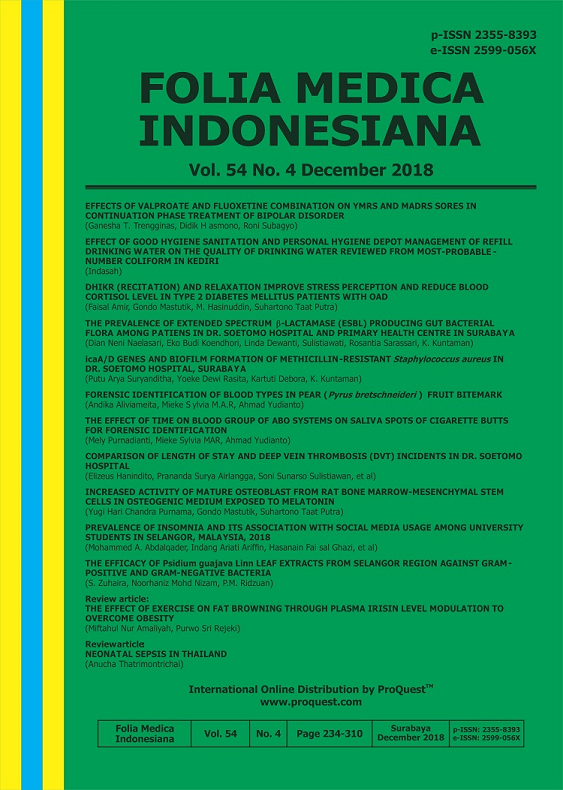Main Article Content
Abstract
Keywords
Article Details
-
Folia Medica Indonesiana is a scientific peer-reviewed article which freely available to be accessed, downloaded, and used for research purposes. Folia Medica Indonesiana (p-ISSN: 2541-1012; e-ISSN: 2528-2018) is licensed under a Creative Commons Attribution 4.0 International License. Manuscripts submitted to Folia Medica Indonesiana are published under the terms of the Creative Commons License. The terms of the license are:
Attribution ” You must give appropriate credit, provide a link to the license, and indicate if changes were made. You may do so in any reasonable manner, but not in any way that suggests the licensor endorses you or your use.
NonCommercial ” You may not use the material for commercial purposes.
ShareAlike ” If you remix, transform, or build upon the material, you must distribute your contributions under the same license as the original.
No additional restrictions ” You may not apply legal terms or technological measures that legally restrict others from doing anything the license permits.
You are free to :
Share ” copy and redistribute the material in any medium or format.
Adapt ” remix, transform, and build upon the material.

References
- Cushman, M. 2007. Epidemiology and Risk Factors for Venous Thrombosis. SeminHematol. April ; 44(2): 62
- Fauci, AS, DL Kasper, DL Longo, E Braunwald, SL Hauser, JL Jameson, JLoscalzo. 2008. Venous Thrombosis. Dalam: Harrison's Principles of Internal Medicine 17th Edition. Chapter 111. USA: McGraw-Hill Companies,Inc.7.
- Hirsh, J dan J Hoak. 1996. Management of Deep Vein Thrombosis and Pulmonary Embolism Circulation. http://circ.ahajournals.org/content/93/12/2212.full. 5 November 2014, (22.00)
- Hirsh, J, RD Hull, dan GE Raskob. 1986. Epidemiology and Pathogenesis of Venous Thrombosis. The J Am Coll Cardio. http://content.onlinejacc.org/data/Journals/JAC/22739/00122.pdf. 5 November 2014, (22.00)
- Kaushansky, K, MA Lichtman, E Beutler, TJ Kipps, U Seligsohn, JT. Prchal. 2010. Venous Thrombosis. 2700. Williams Hematology, 8th edition. China: TheMcGraw-Hill Companies, Inc. P.
- Kerr T.M et al. 1990. Upper Extremity Venous Thrombosis Diagnosed by DuplexScanning, The Am J of Surgery 160:120-206.10
- Lopez, JA, C Kearon, dan AYY Lee. 2004. Deep Venous Thrombosis. Hematology. ASH Education Book January 1: vol. 2004 no. 1 439-4563.
- Schellong S, Hesselschwerdt HJ, Paar WD, et al. 2005. Rates of proximal deep vein thrombosis as assessed by compression ultrasonography in patients receiving prolonged thromboprophylaxis with low molecular weight heparin after major orthopedic surgery. Thromb Haemost; 94: 532-6
- White, R. 2003. The Epidemiology of Venous Thromboembolism. Circulation. http://circ.ahajournals.org/content/107/23_suppl_I/I-4. 7 November 2014 (20:00)
References
Cushman, M. 2007. Epidemiology and Risk Factors for Venous Thrombosis. SeminHematol. April ; 44(2): 62
Fauci, AS, DL Kasper, DL Longo, E Braunwald, SL Hauser, JL Jameson, JLoscalzo. 2008. Venous Thrombosis. Dalam: Harrison's Principles of Internal Medicine 17th Edition. Chapter 111. USA: McGraw-Hill Companies,Inc.7.
Hirsh, J dan J Hoak. 1996. Management of Deep Vein Thrombosis and Pulmonary Embolism Circulation. http://circ.ahajournals.org/content/93/12/2212.full. 5 November 2014, (22.00)
Hirsh, J, RD Hull, dan GE Raskob. 1986. Epidemiology and Pathogenesis of Venous Thrombosis. The J Am Coll Cardio. http://content.onlinejacc.org/data/Journals/JAC/22739/00122.pdf. 5 November 2014, (22.00)
Kaushansky, K, MA Lichtman, E Beutler, TJ Kipps, U Seligsohn, JT. Prchal. 2010. Venous Thrombosis. 2700. Williams Hematology, 8th edition. China: TheMcGraw-Hill Companies, Inc. P.
Kerr T.M et al. 1990. Upper Extremity Venous Thrombosis Diagnosed by DuplexScanning, The Am J of Surgery 160:120-206.10
Lopez, JA, C Kearon, dan AYY Lee. 2004. Deep Venous Thrombosis. Hematology. ASH Education Book January 1: vol. 2004 no. 1 439-4563.
Schellong S, Hesselschwerdt HJ, Paar WD, et al. 2005. Rates of proximal deep vein thrombosis as assessed by compression ultrasonography in patients receiving prolonged thromboprophylaxis with low molecular weight heparin after major orthopedic surgery. Thromb Haemost; 94: 532-6
White, R. 2003. The Epidemiology of Venous Thromboembolism. Circulation. http://circ.ahajournals.org/content/107/23_suppl_I/I-4. 7 November 2014 (20:00)

